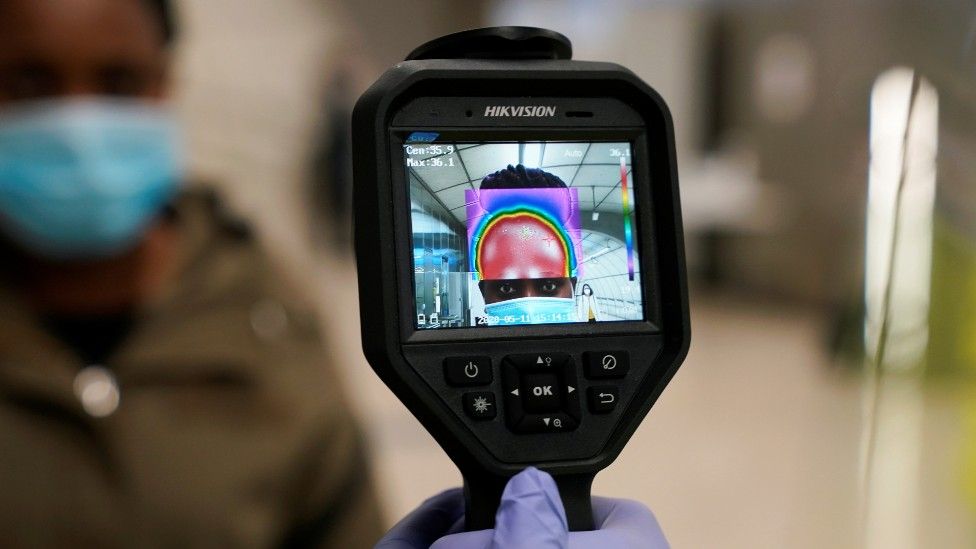Can thermal cameras help spot coronavirus?
- Published

As lockdowns ease, thermal imaging cameras are popping up in all sorts of public places to assess the state of people's health.
What do thermal imaging cameras do?
Using infrared technology, thermal cameras detect radiating heat from a body - usually from the forehead - and then estimate core body temperature. These cameras are an extremely powerful tool, often deployed by fire fighters to track smouldering embers and police to search for out-of-sight suspects.
But they are not designed to be medical devices. So how useful are they in the current pandemic?
They can give a reasonable measure of skin temperature, to within half a degree - but that's not the same as body temperature.
"These devices, in general, are less accurate than medical device thermometers like those you stick in the ear," says Derek Hill, professor of medical imaging science from University College London.
What is normal body temperature?
About 37C (98.6F). A high temperature is usually considered to be 38C or over. But normal temperature can vary from person to person and change during the day. It can also fluctuate during a woman's monthly cycle.
Taking an accurate reading of core body temperature isn't easy. Although it can be measured on the forehead, in the mouth, the ear and the armpit, the most accurate way is to take a rectal reading.
37°C(98.6°F) normal body temperature
38°C(100.4°F) or above, high temperature/fever
Do thermal cameras detect coronavirus?
No, they only measure temperature. A high temperature or fever is just one common symptom of the virus. Others include nausea, headaches, fatigue and loss of taste or smell. But not everyone with the virus gets a high temperature and not everyone with a high temperature is infected with coronavirus.
So thermal cameras alone will miss infected people with other symptoms or no symptoms at all - known as false negatives. They will also identify people unwell with a fever for another reason - known as false positives.
So are thermal cameras useful?
On its own, temperature screening "may not be very effective" says the World Health Organization. Cameras have to be set up correctly and take account of ambient temperature. A risk is that cameras can lull operators into a false sense of security.
"They are… only one tool among many," says James Ferryman, professor of computational vision, from the University of Reading.
What if I'm wearing a face mask or covering?
"Heat radiating from the skin will likely be impacted by wearing face masks," says Prof Ferryman.
That's why most temperature measurements are based on the forehead, which is usually exposed.
Will I be hotter if I've been exercising?
Not necessarily. Skin temperature actually goes down during exercise as sweat appears on the surface of the skin.
The body is pretty good at regulating its temperature even after exercise, so it would have to be really quite high to show up.
- FACE MASKS: When should you wear one?
- TESTING: Who can get a test and how?
- SCHOOLS: Which are re-opening, when?
- LOOK-UP TOOL: How many cases in your area?
- TWO METRES: Could less than 2m work?
How else can my temperature be taken?
With portable thermometers pointed at foreheads. They don't need to touch the skin, but do need to be within a few centimetres of it. While accurate to a fraction of a degree on skin temperature, they correctly detect fever about 90% of the time compared with a rectal thermometer, Prof Hill says.
Where can I expect to be temperature tested?
Thermal scanners are now in place at some UK airports - including Bournemouth. Temperature screening is being trialled for some passengers at Heathrow, while Manchester Airport says equipment is also being tested - but results will not be communicated to passengers or "used to influence whether a customer can travel". Portsmouth international ferry port has also installed a thermal scanner to screen departing passengers.
Schools are deploying hand-held laser thermometers to check children each morning. And some employers are looking at introducing staff-testing in workplaces.
At work, do I have to submit to a temperature test?
Under UK employment law, individuals must agree before an employer can temperature-screen members of staff. Some work contracts will already allow for this type of test to be carried out, by so-called "implied consent".
If employees do not consent - and there is no pre-agreed policy covering the situation - then taking someone's temperature is unlawful, says the professional body for HR and people development. Employers must also handle the medical information they gather fairly and transparently - according to the Information Commissioner.
- Published30 April 2020
- Published2 May 2020
- Published6 October 2021
 translator
translator